You’ve heard about blockchain and Bitcoin about a million times by now, and may even own some, but did you know that many governments around the world are actually planning to intertwine blockchain technology in a different way, by combining it with their own countries official currency?
Governments plan to do this by implementing what’s known as a “Central Bank Digital Currency”, or CBDC for short. This solution allows governments to utilize the benefits of blockchain technology, without inhibiting the “risk” of decentralization. In fact, countries like Nigeria have already fully launched a fully operational CBDC for their citizens to use. Check out the maps I created below by clicking on the image, and try to spot some other countries that fully launched a CBDC! (Hint: Think islands!)
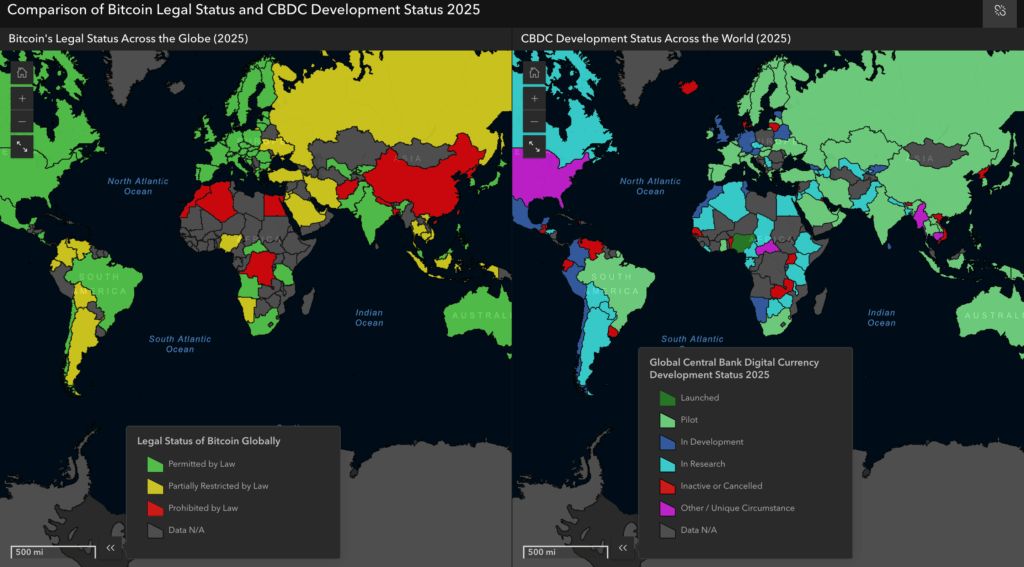
In case maps are not opening from image, try this link: https://torontomu.maps.arcgis.com/apps/instant/compare/index.html?appid=42c8571764d344949f7d80bd62e0be6b
CBDCs are important because they bring the benefits of blockchain technologies, such as transaction traceability (which can reduce fraud, scams, and other financial crimes), reduced friction, and improved transaction speeds with the benefit (or disadvantage, depending on who you ask) of a centralized government authority to monitor the network, meaning blockchain efficiency but without anonymous wallets. During Bitcoin’s inception, some early adopters called for the replacement of the US dollar with Bitcoin instead, making bold predictions that the world would transition to a decentralized financial system. Unfortunately for them, some governments around the world have banned Bitcoin by law.
What is interesting however, is that despite some countries being pro-CBDC, they may be-anti Bitcoin and crypto. For example; China, who outright banned the dealing and trading of Bitcoin by financial institutions, yet piloted the “eCNY” CBDC. (Try finding some other interesting patterns like this in the maps!) Some countries like the USA have researched a CBDC, but have the “CBDC Anti-Surveillance State Act” in place, preventing the Federal Reserve from issuing a CBDC. (Notes like this can be observed for a few countries in my maps, either under the field “CBDC Notes” or “Bitcoin Notes”).
I wanted to highlight some of these patterns, by creating a global map of Bitcoin legality across different countries, with a second displayable layer which includes CBDC development statuses across different countries. On top of that, I also found that existing Bitcoin legality maps online tend to be static, and do not allow for the convenient viewing of smaller countries, despite having relevant Bitcoin legality data, or CBDC development status data. It is worth mentioning that atlanticcouncil.org has already created an interactive “CBDC Tracker” map, however it does not contain any data regarding Bitcoin, preventing the instant viewing of a countries views on both topics (which my maps allow for by clicking on a country!).
Initially, I planned to create a different map, with layers not just displaying Bitcoin legal status across different countries, but also the legal status of altcoins and stablecoins. However, many countries do not have laws regarding altcoins and stablecoins (many don’t even have laws on Bitcoin, as seen in the grey areas of my map), so I decided to switch my projects trajectory a bit to instead focus on Bitcoin and CBDCs, as there clearly is a lot of data on CBDCs, and it is an even newer and more novel concept compared to traditional decentralized cryptocurrencies.
Map Creation Process:
The creation of my maps took a few steps. Firstly, I had to gather data. This proved relatively simple, as there was a convenient Wikipedia article (I know, I know, but its data was referenced!) that already listed Bitcoin legality across countries that had laws regarding it. I grouped legality into three categories: 1) Permitted By Law, 2) Partially Restricted by Law, and 3) Prohibited by Law. The next step, was to find a shapefile that contained the world’s countries. This was found on ArcGIS Hub, and was as follows:
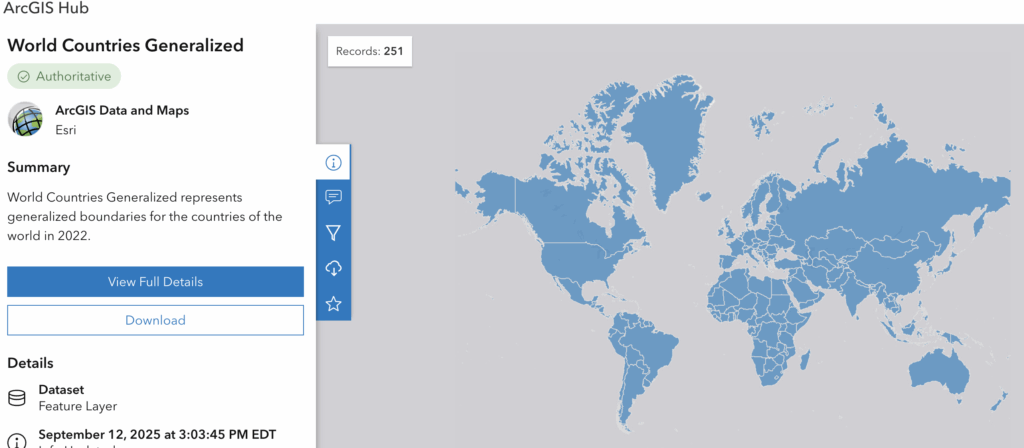
I noticed it could not be edited, so I had to save it as a new feature layer in ArcGIS Online in order to do the necessary joins.
Next, creation of the .CSV file for joining. First, I copied the “Countries” column from the countries shapefile, then pasted it into a new .CSV. The rest was pretty simple, but tedious, as I manually went back and forth inputting the Bitcoin legality data for each country that contained it. This was done by inputting a 0 for prohibited, a 1 for permitted, and a 2 for partially restricted. I then used an IF statement to create the text column with “Permitted by Law”, “Prohibited by Law” and “Partially Restricted by Law”.
Next, I had to find data on CBDC development statuses around the world, and conveniently enough, atlanticcouncil.org has already created an interactive map that does just this, as mentioned earlier. I did however, find their map’s use of colours to be quite confusing (why is “launched” in pink!?). To add the data, I manually looked at each countries CBDC status, and included it into my .CSV into a new column. I also combined “Inactive” and “Cancelled” into the same category as “Inactive or Cancelled” to reduce the number of legend items, and for simplistic reading. Lastly, notes columns were added for any countries that may include, well, notable details regarding their CBDC status or Bitcoin legality status. In the end, my .CSV looked something like this:
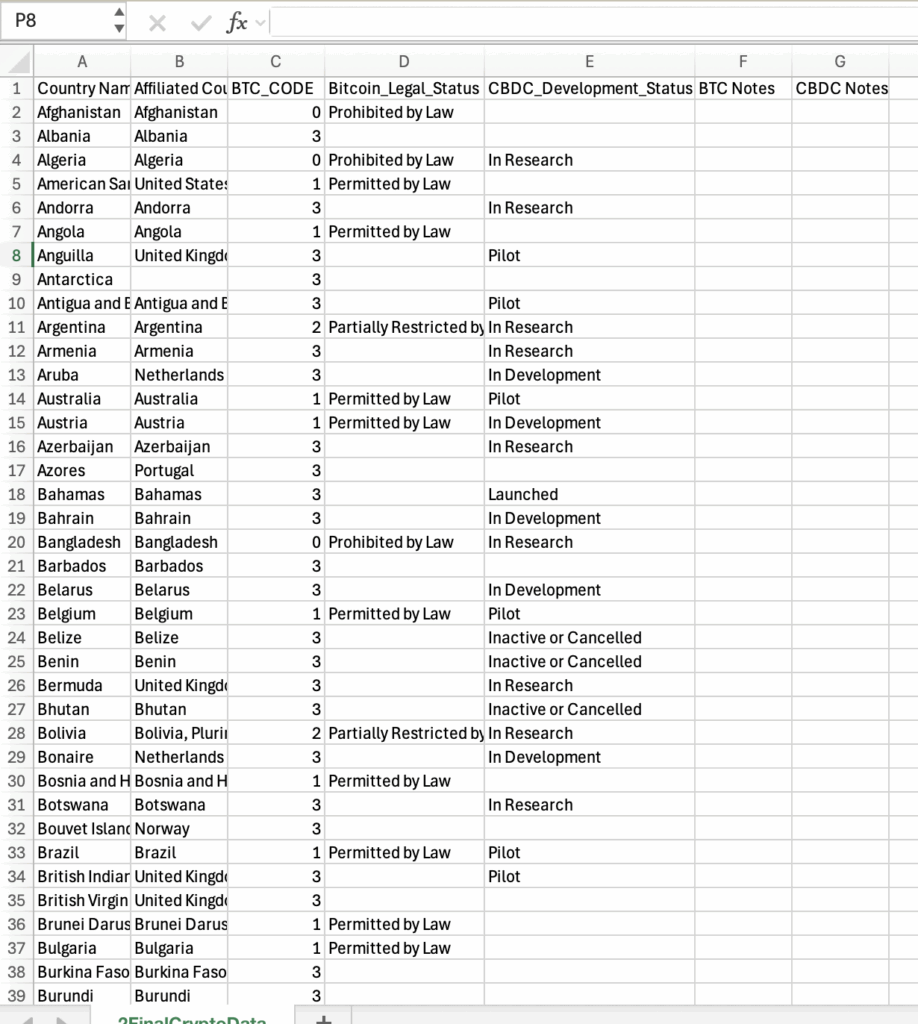
Once the data was ready, it was time to map! I simply joined the countries shapefile to my data file, once for the “Bitcoin_Legal_Status” and once for the “CBDC_Development_Status”.
The resulting map layers were created:
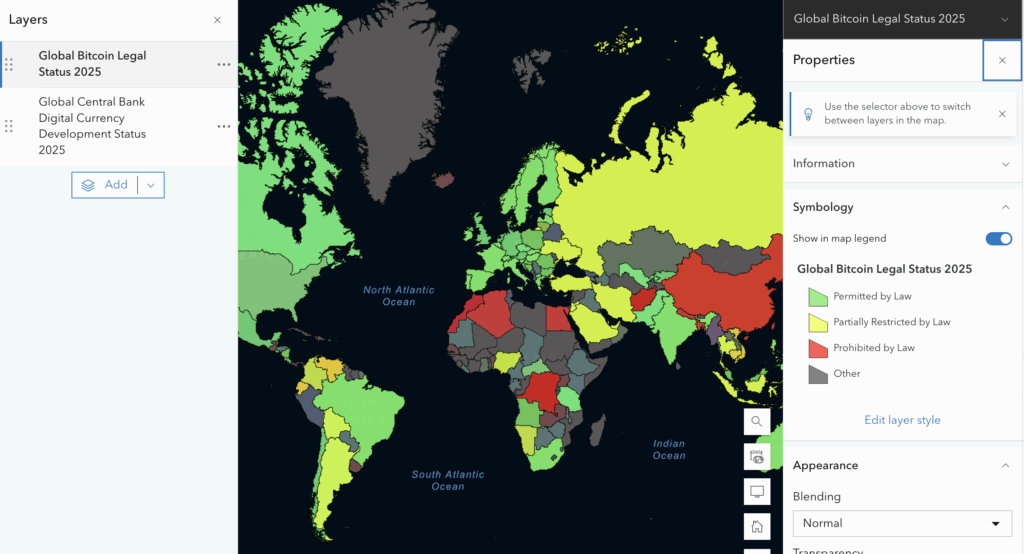
Global Bitcoin Legal Status.
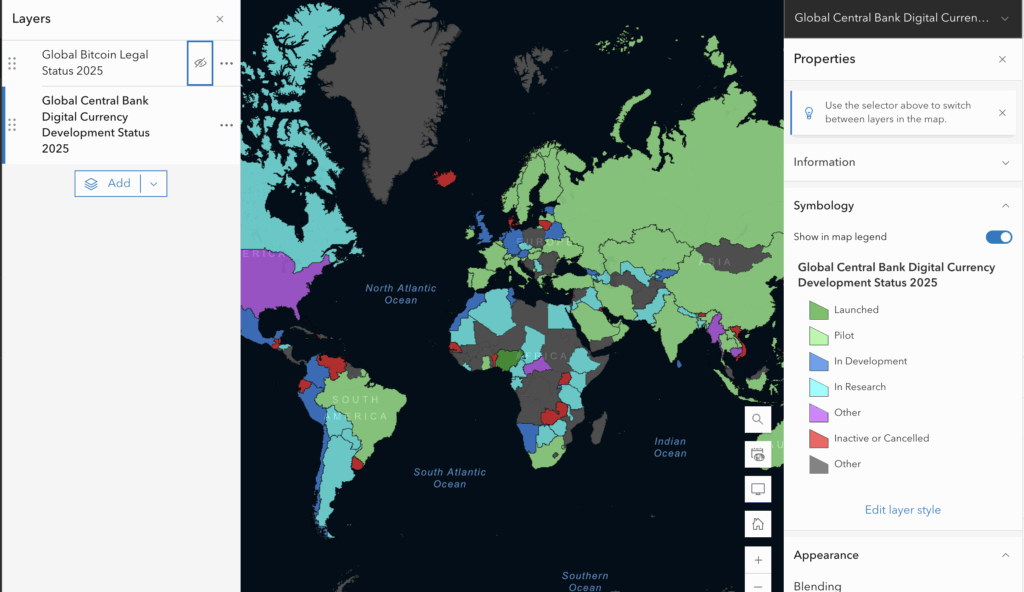
Global Central Bank Digital Currency Development Status.
Next, I had to publish each layer as individual web maps. This would allow me to get to my next step of creating the web app.
ArcGIS Online allows for the creation of web apps, known as “Instant Apps”. I created a “Compare” app, allowing for the side by side comparison of multiple web maps. I simply selected my maps, toggled a few settings, and my app was ready to go!
The world is changing fast, I think these maps highlight interesting dichotomies in some government’s views on blockchain technologies, the difference may simply just be if they can track who’s spending their CBDC’s and on what, as tracking anonymous Bitcoin transactions can be challenging. Invasion of privacy and government overreach or public safety and the future of finance? What do you think?
This blog post and map application was created for the SA8905 course at Toronto Metropolitan University taught by Dr. Claus Rinner.